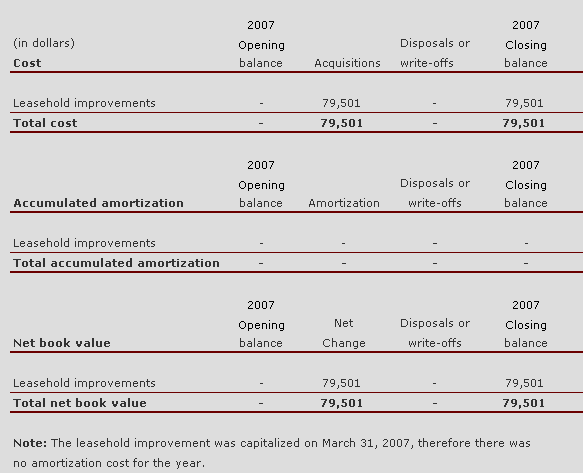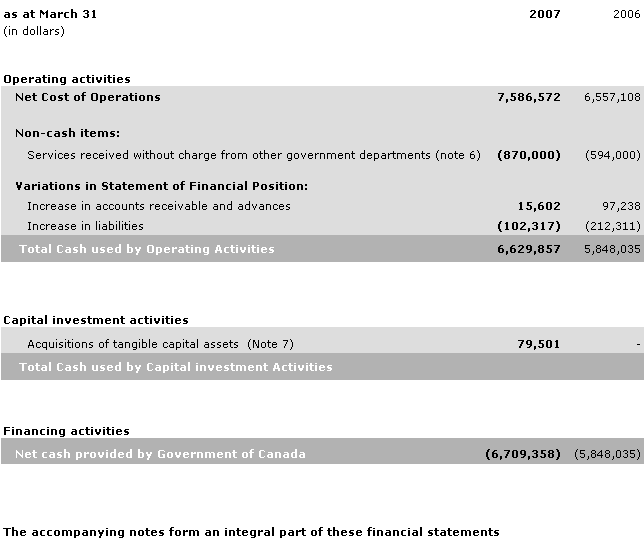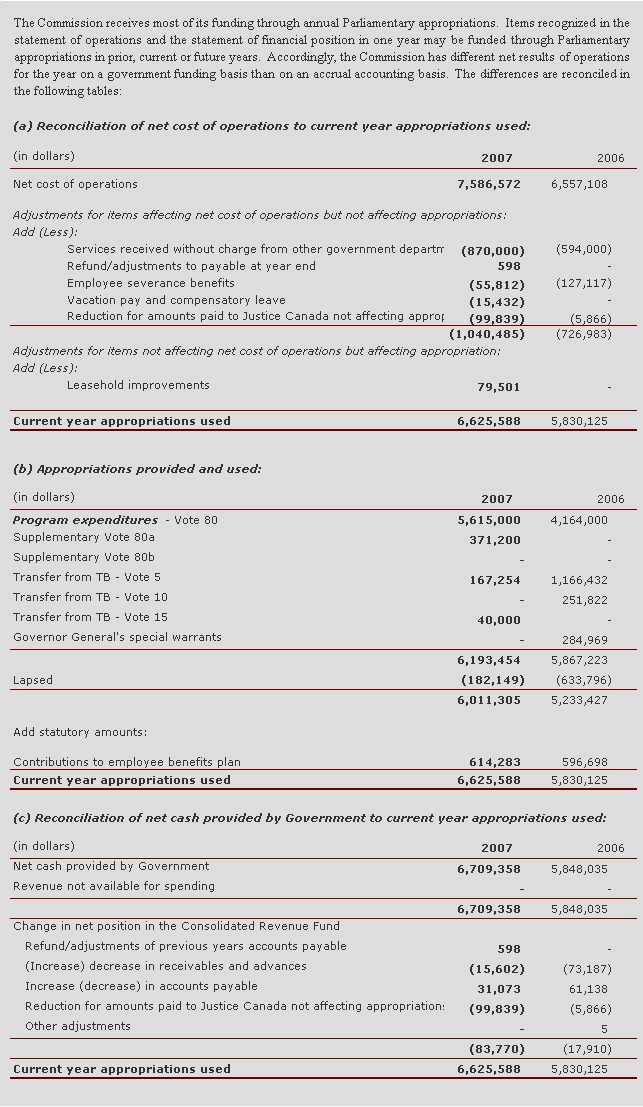Common menu bar links
Breadcrumb Trail
ARCHIVED - Commission for Public Complaints Against the RCMP
 This page has been archived.
This page has been archived.
Archived Content
Information identified as archived on the Web is for reference, research or recordkeeping purposes. It has not been altered or updated after the date of archiving. Web pages that are archived on the Web are not subject to the Government of Canada Web Standards. As per the Communications Policy of the Government of Canada, you can request alternate formats on the "Contact Us" page.
SECTION 3 - SUPPLEMENTARY INFORMATION
Organizational Information
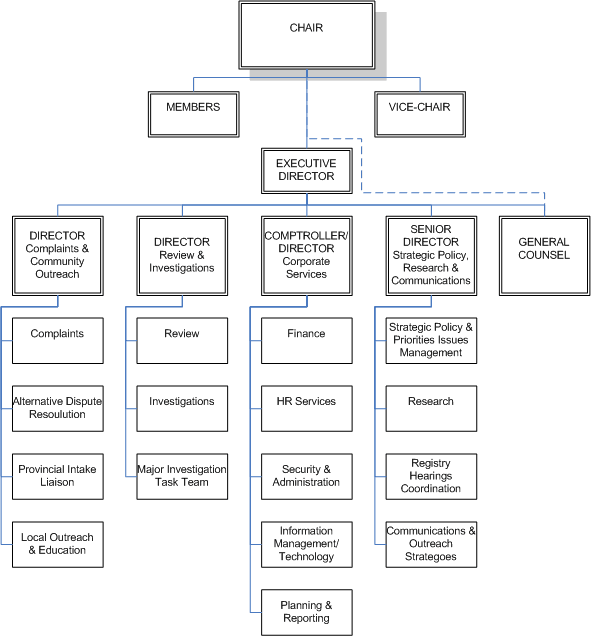
Chair
The Chair, a Governor-in-Council appointee, is the Chief Executive Officer and a full-time member of the CPC. The Chair is appointed by order of the Governor in Council and has supervision over and direction of the work and staff of the CPC. The current Chair was appointed in October of 2005.
The Chair has a full-time Vice-Chair who reports directly to him. The Chair may delegate to the Vice-Chair any of his powers, duties or functions, except the power to delegate and the duty to submit an annual report for tabling in Parliament.
The Chair may have a complement of full or part-time members who may be assigned to conduct hearings. Reporting directly to the Chair are the Vice-Chair, Executive Director and the General Counsel.
Vice-Chair
The Vice-Chair of the CPC, a Governor-in-Council appointee, assists and supports the Chair. The Vice-Chair may be called upon to undertake special projects. The Vice-Chair has been delegated by the Chair with the responsibility for the elimination of the backlog, implementation of performance based service standards; and the preparation and delivery of interim and final reports following reviews, investigations and hearings, including the findings and recommendations contained therein.
Members
Members of the CPC are appointed on a part-time basis by order of the Governor in Council for each province and territory that contracts for RCMP services, after consultation with the Minister or other elected representatives responsible for policing affairs in that province or territory. The CPC does not currently have any part-time members.
Executive Director
The Executive Director is a permanent position in the EX category reporting to the Chair and responsible for providing support to the Chair; leadership, strategic direction and review over the resources, operations, management and administrative infrastructure of the CPC; the continuing review, evaluation, streamlining and evolution of policies and processes; the management framework, and service delivery strategy; the development and implementation of a communications strategy; constructive relations with the RCMP and the provinces/territories; and the provision of advice on administrative matters to the Chair.
General Counsel
The General Counsel is a permanent position in the LA category reporting to the Chair in his/her capacity of counsel and to the Executive Director for administrative matters. The General Counsel is responsible for the management of the Legal Services Unit; the provision of legal advice, opinions and expertise to the CPC.
Financial Performance
Table 1: Comparison of Planned to Actual Spending (including FTEs)
This table offers a comparison of the Main Estimates, planned spending, total authorities, and actual spending for the most recently completed fiscal year, as well as historical figures for actual spending. If necessary, explain any negative or positive variances between the categories.
| ($000) | 2004-2005 Actual | 2005-2006 Actual | 2006-2007 | |||
|---|---|---|---|---|---|---|
| Main Estimates | Planned Spending | Total Authorities | Total Actuals | |||
| Civilian review of RCMP members’ conduct in the performance of their duties | 4,820 | 5,830 | 6,303 | 6,466 | 6,193 | 6,626 |
| Total | 4,820 | 5,830 | 6,303 | 6,466 | 6,193 | 6,626 |
| Less: Non-respendable revenue | N/A | N/A | ||||
| Plus: Cost of services received without charge | 580 | 594 | N/A | 870 | 870 | 870 |
| Total Departmental Spending | 5,400 | 6,424 | 6,303 | 7,336 | 7,063 | 7,496 |
| Full-time Equivalents | 44 | 44 | 44 | 44 | 44 | 44 |
Table 2: Resources by Program Activity
($000)
| 2006–2007 | |||||||||
|---|---|---|---|---|---|---|---|---|---|
| Program Activity |
Budgetary | Plus: Non- budgetary |
Total | ||||||
| Operating | Capital | Grants | Contribu-tions and Other Transfer Payments | Total: Gross Budgetary Expendi-tures | Less: Respend-able Revenue |
Total: Net Budgetary Expendi-tures |
Loans, Invest-ments, and Advances |
||
| Civilian review of RCMP members’ conduct in the performance of their duties | |||||||||
| Main Estimates | 6,303 | 6,303 | 6,303 | 6,303 | |||||
| Planned Spending | 6,466 | 6,466 | 6,466 | 6,466 | |||||
| Total Authorities | 6,881 | 6,881 | 6,881 | 6,881 | |||||
| Actual Spending | 6,626 | 6,626 | 6,626 | 6,626 | |||||
Table 3: Voted and Statutory Items
($000)
| Vote or Statutory Item | Truncated Vote or Statutory Wording | 2006-2007 | |||
|---|---|---|---|---|---|
| Main Estimates |
Planned Spending |
Total Authorities |
Actual | ||
| 80 | Operating Expenditures | 5,615 | 5,778 | 5,578 | 6,011 |
| (S) | Contributions to employee benefit plans | 688 | 688 | 615 | 615 |
| Total | 6,303 | 6,466 | 6,193 | 6,626 | |
Table 4: Services Received Without Charge
| 2006-2007 Actual Spending ($000) |
|
|---|---|
| Accommodation provided by Public Works and Government Services Canada | 580 |
|
Contributions covering employer’s share of employees’ insurance premiums and expenditures paid by Treasury Board of Canada Secretariat (excluding revolving funds) |
290 |
|
Total 2006-2007 Services received without charge |
870 |
Table 6: Response to Parliamentary Committees, Audits and Evaluations
| Response to Parliamentary Committees |
| Provide a brief summary of any reports and add a link to the department's response. (If no recommendations were received, this should also be noted.) As appropriate, make references in the DPR. |
| N/A |
| Response to the Auditor General (including to the Commissioner of the Environment and Sustainable Development) |
| Provide a brief summary of any chapters of reports and add a link to the department's response. (If no recommendations were received, this should also be noted.) As appropriate, make references in the DPR. |
| N/A |
| External Audits (Note: These refer to other external audits conducted by the Public Service Commission of Canada or the Office of the Commissioner of Official Languages.) |
| Indicate the name of the audit (as required, make appropriate references in the DPR and add Web links). |
| N/A |
| Internal Audits or Evaluations |
| Indicate the name of the audit or evaluation (as required, make appropriate references in the DPR and add Web links). If there is a change from the RPP, please explain. |
| N/A |
Table 7: Travel Policies
Step 1: Comparison to the Treasury Board of Canada Secretariat Special Travel Authorities
Travel policy of The Commission for Public Complaints Against the RCMP.
The Commission for Public Complaints Against the RCMP follows the Treasury Board of Canada Secretariat Special Travel Authorities.
Authority: N/A
Coverage: N/A
Principal difference(s) in policy provisions: N/A
Principal financial implications of the difference(s): N/A
Step 2: Comparison to the Treasury Board of Canada Secretariat Travel Directive, Rates and Allowances
Travel policy of The Commission for Public Complaints Against the RCMP.
The Commission for Public Complaints Against the RCMP follows the Treasury Board of Canada Secretariat Special Travel Authorities.
Authority: N/A
Coverage: N/A
Principal difference(s) in policy provisions: N/A
Principal financial implications of the difference(s): N/A
Table 8: Departmental Financial Tables
Statement of Management Responsibility (unaudited)
Responsibility for the integrity and objectivity of the accompanying financial statements for the year ended March 31, 2007 and all information contained in these statements rests with departmental management. These financial statements have been prepared by management in accordance with Treasury Board accounting policies which are consistent with Canadian generally accepted accounting principles for the public sector.
Management is responsible for the integrity and objectivity of the information in these financial statements. Some of the information in the financial statements is based on management's best estimates and judgment and gives due consideration to materiality. To fulfill its accounting and reporting responsibilities, management maintains a set of accounts that provides a centralized record of the department's financial transactions. Financial information submitted to the Public Accounts of Canada and included in the Commission's Departmental Performance Report is consistent with these financial statements.
Management maintains a system of financial management and internal control designed to provide reasonable assurance that financial information is reliable, that assets are safeguarded and that transactions are in accordance with the Financial Administration Act, are executed in accordance with prescribed regulations, within Parliamentary authorities, and are properly recorded to maintain accountability of Government funds. Management also seeks to ensure the objectivity and integrity of data in its financial statements by careful selection, training and development of qualified staff, by organizational arrangements that provide appropriate divisions of responsibility, and by communication programs aimed at ensuring that regulations, policies, standards and managerial authorities are understood throughout the Commission.
The financial statements of the Commission have not been audited.

Statement of Financial Position (unaudited)
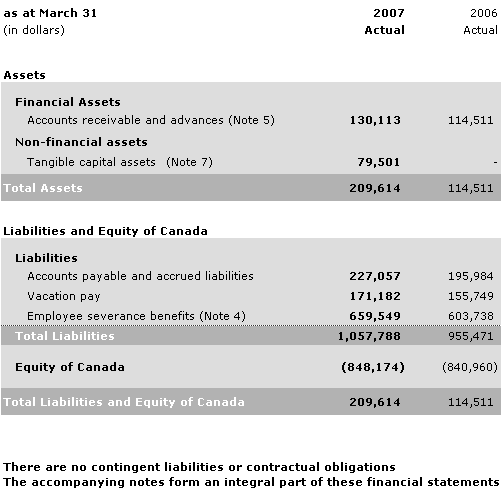
Statement of Equity of Canada (unaudited)
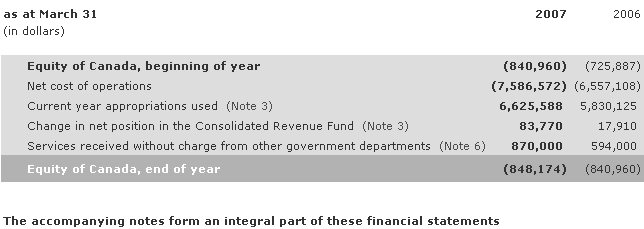
Statement of Operations (unaudited)
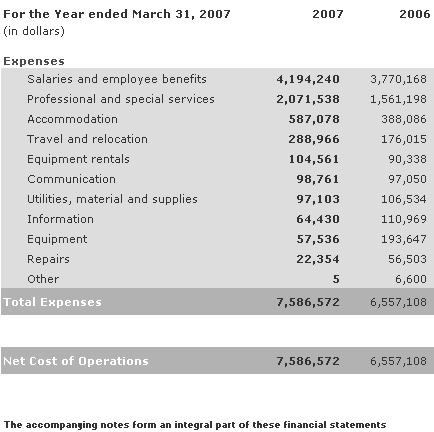
Statement of Cash Flow (unaudited)
Notes to the Financial Statements (unaudited)
1. Authority and purpose
The Commission for Public Complaints Against the RCMP is a federal agency that receives and reviews public complaints about the conduct of members of the RCMP in the performance of any duty or function under the Royal Canadian Mounted Police Act. The Commission is entirely separate from and independent of the RCMP. The mandate of the Commission is set out in Part VII of the Royal Canadian Mounted Police Act and can be summarized as follows:
- To receive complaints from the public about the conduct of RCMP members;
- To conduct reviews when complainants are not satisfied with the RCMP’s disposition of their complaints;
- To hold hearings and investigations; and
- To report findings and recommendations.
2. Significant accounting policies
The financial statements have been prepared in accordance with Treasury Board accounting policies which are consistent with Canadian generally accepted accounting principles for the public sector.
Significant accounting policies are as follows:
(a) Parliamentary appropriations
The Commission is financed by the Government of Canada through Parliamentary appropriations. Appropriations provided to the Commission do not parallel financial reporting according to generally accepted accounting principles since appropriations are primarily based on cash flow requirements. Consequently, items recognized in the statement of operations and the statement of financial
position are not necessarily the same as those provided through appropriations from Parliament. Note 3 provides a high-level reconciliation between the bases of reporting.
(b) Net Cash Provided by Government
The Commission operates within the Consolidated Revenue Fund (CRF), which is administered by the Receiver General for Canada. All cash received by the Commission is deposited to the CRF and all cash disbursements made by the Commission are paid from the CRF. The net cash provided by Government is the difference between all cash receipts and all cash disbursements including
transactions between departments of the federal government.
(c) Change in net position in the Consolidated Revenue Fund
Change in net position in the Consolidated Revenue Fund is the difference between the net cash provided by Government and appropriations used in a year, excluding the amount of non respendable revenue recorded by the Commission. It results from timing differences between when a transaction
affects appropriations and when it is processed through the CRF.
(d) Expenses
Expenses are recorded on the accrual basis:
- Vacation pay and compensatory leave are expensed as the benefits accrue to employees under their respective terms of employment.
- Services provided without charge by other government departments for accommodation and the employer's contribution to the health and dental insurance plans are recorded as operating expenses at their estimated cost.
(e) Employee future benefits
- Pension benefits: Eligible employees participate in the Public Service Pension Plan, a multiemployer administered by the Government of Canada. The Commission's contributions to the Plan are charged to expenses in the year incurred and represent the total obligation to the Plan. Current legislation does not require the Commission to make contributions for any actuarial deficiencies of the Plan.
- Severance benefits: Employees are entitled to severance benefits under labour contracts or conditions of employment. These benefits are accrued as employees render the services necessary to earn them. The obligation relating to the benefits earned by employees is calculated using information derived from the results of the actuarially determined liability for employee severance benefits for the Government as a whole.
(f) Receivables
Accounts receivables are stated at amounts expected to be ultimately realized; a provision is made for receivables where recovery is made for receivables where recovery is considered uncertain.
(g) Tangible capital assets
All tangible capital assets and leasehold improvements having an initial cost of $10,000 or more are recorded at their acquisition cost. The department does not capitalize intangibles, works of art and historical treasures that have cultural, aesthetic or historical value, assets located on Indian Reserves and museum collections.
Amortization of tangible capital assets is done on a straight-line basis over the estimated useful life of the asset as follows:
| Asset Class | Amortization Period |
|---|---|
| Informatics hardware | 4 years |
| Informatics software | 3 years |
| Motor Vehicles | 3 years |
| Leasehold improvements | remaining term of the lease or useful life of the improvement |
(h) Measurement uncertainty
The preparation of these financial statements in accordance with Treasury Board accounting policies, which are consistent with Canadian generally accepted accounting principles for the public sector, requires management to make estimates and assumptions that affect the reported amounts of assets, liabilities, revenues and expenses reported in the financial statements. At the time of
preparation of these statements, management believes the estimates and assumptions to be reasonable. The most significant items where an estimate is used is the liability for employee severance benefits. Actual results could significantly differ from those estimated. Management's estimates are reviewed periodically and, as adjustments become necessary, they are recorded in the
financial statements in the year they become known.
3. Parliamentary appropriations
4. Employee Benefits
(a) Pension benefits
The Commission's employees participate in the Public Service Pension Plan, which is sponsored and administered by the Government of Canada. Pension benefits accrue up to a maximum period of 35 years at a rate of 2 percent per year of pensionable service, times the average of the best five consecutive years of earnings. The benefits are integrated with Canada/Qu�bec Pension Plans
benefits and they are indexed to inflation.
Both the employees and the Commission contribute to the cost of the Plan. The 2006-2007 expense amounts to $452,726 ($441,557 in 2005-2006), which represents approximately 2.2 times (2.6 in 2005-2006) the contributions by employees.
The Commission's responsibility with regard to the Plan is limited to its contributions. Actuarial surpluses or deficiencies are recognized in the financial statements of the Government of Canada, as the Plan's sponsor.
(b) Severance benefits
The Commission provides severance benefits to its employees based on eligibility, years of service and final salary. The accrued benefit obligation at the end of the year is calculated by multiplying a ratio (23.20 percent for 2006 and 23.64 percent for 2007) to the Commission's annual gross payroll at year end subject to severance pay, which is the payroll related to indeterminate
employees. The ratios are determined by Treasury Board Secretariat. These severance benefits are not pre-funded. Benefits will be paid from future appropriations. Information about the severance benefits, measured as at March 31, is as follows:
| (in dollars) |
2007
|
2006
|
|---|---|---|
| Accrued benefit obligation, beginning of year | 603,738 | 476,622 |
| Expense for the year | 100,203 | 127,833 |
| Benefits paid during the year | (44,392) | (717) |
| Accrued benefit obligation, end of year | 659,549 | 603,738 |
5. Accounts receivable and advances

6. Related party transactions
The Commission is related as a result of common ownership to all Government of Canada departments, agencies, and Crown corporations. The Commission enters into transactions with these entities in the normal course of business and on normal trade terms. Also, during the year, the Commission received services which were obtained without charge from other Government departments as presented in part (a).
(a) Services received without charge from other government departments
During the year the Commission received service without charge from other departments. These services have been recognized in the Commission's Statement of Operations as follows:
| (in dollars) |
2007
|
2006
|
|---|---|---|
| Accommodation | 580,000 | 386,000 |
| Employer's contribution to the health and dental insurance plans | 290,000 | 208,000 |
| Total | 870,000 | 594,000 |
The Government has structured some of its administrative activities for efficiency and cost-effectiveness purposes so that one department performs these on behalf of all without charge. The costs of these services, which include payroll and cheque issuance services provided by Public Works and Government Services Canada and audit services provided by the Office of the Auditor General, are not included as an expense in the Commission's Statement of Operations
7. Tangible capital assets
